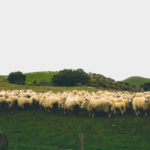The live sheep export industry is an important industry to Australia, providing a vital market for sheep producers to sell their livestock to and underpinning the domestic sheep farming industry.
The majority of sheep are exported from the port of Fremantle in Western Australia, with almost three quarters of Australian sheep exported from this port in 2009. Over 50% of sheep from the sheep production industry in Western Australia are exported live overseas, making the industry especially important to the Western Australian economy. Other ports that export live sheep include Portland and Port Adelaide.
Australian sheep are exported to countries across the Middle East, primarily Kuwait, Saudi Arabia, Oman, Bahrain, Jordan, Qatar and the UAE. In 2009 over 3.5 million sheep were exported to these countries, with Kuwait taking 950,000 head and and Bahrain taking 747,000 head of sheep respectively. The number of sheep exported in 2009 represented a drop of 15% on the previous year, with demand for the live export of sheep far outstripping supply in the Australian sheep production industry last year. This has resulted in calls for the sheep farming industry to rebuild sheep flocks in the coming years.
In 2009 the live export of sheep contributed A$323 million to the Australian economy.
Australia also has a live cattle export industry and a live goat export industry, primarily exporting to countries throughout South East Asia. Indonesia is the primary market for the live cattle export industry, and Malaysia is the primary market for the live goat export industry. The live cattle export industry contributed A$662 million to the Australian economy in 2009, and the live goat export industry contributed A$11.5 million.
Australia is also involved in the meat export industry, exporting chilled and frozen beef, sheep and goat meat products to countries across the world in addition to exporting livestock. This is because there is demand for red meat products as well as livestock from overseas countries, and Meat and Livestock Australia invests in promoting all of these products to consumers overseas.
This is why arguments that Australia could cease supplying live sheep exports and replace them with sheep meat exports are not realistic. The two trades are complementary, and it is not as simple as replacing one trade with the other as they serve the needs of different consumers in Middle Eastern markets.
Meat and Livestock Australia and LiveCorp invest heavily in improving the welfare of sheep, cattle and goats throughout the livestock export industry.
This investment involves programs to improve the welfare of live sheep exports once they arrive in the Middle East. This includes employing a team of animal welfare experts that work with local veterinarians, stockmen, truck drivers, feedlot operators and port staff to improve how Australian sheep are cared for in the region.
This team provides training courses to local workers, upgrades facilities and installs new equipment and infrastructure to improve the care of Australian sheep overseas.
Highlights of this work in 2009 included the development of a sheep trolley, which assists local workers in the Middle East to move sheep humanely and efficiently. The trolleys have been distributed to each major importing country in the region and allow sheep to be comfortably wheeled from feedlots to processing facilities.
It also included the installation of new port discharge facilities in Kuwait, which have ensured sheep are able to be unloaded in Shuwaikh Port safely and securely.
This work has made a significant difference to the welfare of live sheep exports from Australia, and the live sheep export industry is committed to continuing to improve animal welfare in the countries we export to.
Learn more about live sheep exports [http://www.liveexportcare.com.au/GetTheFacts/AboutLivestockExports/] and cattle live exports [http://www.liveexportcare.com.au/] by visiting the Live Export Care web




